Email marketing remains one of the most effective channels for reaching and engaging audiences. Among the various metrics used to gauge the success of email campaigns, the open rate stands out as a crucial indicator of how well your messages are capturing your audience’s attention. But what exactly constitutes a “good” open rate for email? The answer isn’t straightforward, as it depends on numerous factors unique to your industry, audience, and the type of emails you send. In this comprehensive guide, we’ll delve into the intricacies of email open rates, explore key factors that influence them, and provide actionable strategies to help you achieve and surpass your email marketing goals.
Key Facts About Email Open Rates
Understanding the landscape of email open rates is essential for setting realistic expectations and benchmarks for your campaigns. Here are some key facts to consider:
- Industry Variations: Average open rates can range significantly across different industries, from as low as 15% to as high as 46%.
- B2C vs. B2B: Business-to-Consumer (B2C) emails typically achieve higher open rates (19.7%) compared to Business-to-Business (B2B) emails (15.1%).
- Email Types: Welcome emails are the top performers, often reaching open rates of up to 86%, while promotional emails average around 21%.
- Global Averages: On average, automated emails see an open rate of 35.33%, highlighting the effectiveness of targeted, automated campaigns.
Upgrade Your Email Marketing with AI Personalization!
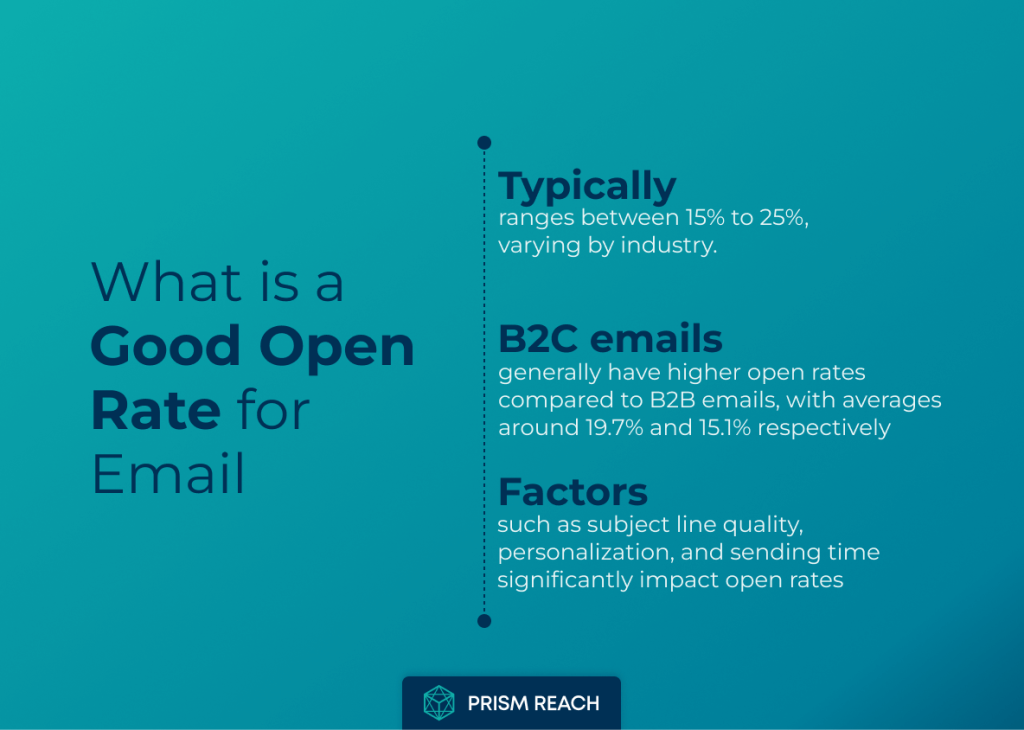
Decoding the Enigma: What Really Constitutes a Good Open Rate?
In general, a good open rate for email campaigns falls between 15% and 25%. However, this benchmark can shift based on several factors:
How Do Industry Averages Impact What’s Considered “Good”?
Industry-specific benchmarks are crucial for evaluating your open rates accurately. For instance:
- Government: Achieves the highest average open rates at 46.3%.
- Hobbies: Follow closely with open rates around 27.74%.
- Real Estate: Sees average open rates of 19.17%.
- Marketing/Advertising: Typically has lower open rates, around 18.39%.
Comparing your open rates to these industry-specific benchmarks rather than general averages provides a more accurate assessment of your campaign’s performance.
Why Do B2C and B2B Emails Have Different Open Rate Benchmarks?
The distinction between B2C and B2B emails is primarily driven by the nature of their content and the relationship with the recipient:
- B2C Emails: More personal and emotionally driven, appealing to individual interests and desires, leading to higher open rates.
- B2B Emails: More formal and information-focused, targeting busy professionals who may be more selective about which emails they open.
However, the lines are blurring as B2B marketers adopt more personalized and emotionally resonant approaches traditionally associated with B2C communications.
How Can Different Email Types Dramatically Affect Open Rates?
The type of email you send significantly impacts your open rates:
- Welcome Emails: Can achieve open rates of up to 86% due to the recipient’s recent engagement with your brand.
- Transactional Emails: Often reach open rates between 80-85%, as they contain important information like order confirmations or shipping notifications.
- Promotional Emails: Average open rates around 21%, but can be boosted with strategic approaches.
Understanding these variations helps in strategizing your email campaigns more effectively.
Factors Influencing Email Open Rates
Several factors play a pivotal role in determining your email open rates. Here are the most influential ones:
Subject Line Effectiveness
Your subject line is the first impression your email makes. Crafting compelling subject lines can significantly boost open rates. Here are some strategies:
- Personalization: Including the recipient’s name or personalized content can increase open rates by up to 26%.
- Curiosity Gap: Creating subject lines that hint at valuable information without revealing everything can leverage human curiosity to encourage opens.
- Humor and Wit: Subject lines with humor, puns, or wit can increase open rates by up to 40%.
- Shocking or Controversial: Using unexpected or slightly controversial subject lines can grab attention, though it should align with your brand and audience.
Timing and Frequency
When you send your emails can be just as important as what you send. Optimal send times can vary based on your audience’s habits and industry standards:
- Best Days: Tuesdays and Thursdays often yield the best results, but this can vary.
- Best Times: Common peak times are 10 a.m. and 3 p.m., but specific industries may have different optimal times.
- Frequency: Balancing frequency is key; too many emails can lead to fatigue, while too few can reduce engagement.
Segmentation and Personalization
Segmenting your email list and personalizing content ensures that each subscriber receives relevant information, significantly boosting open rates:
- Advanced List Segmentation: Dividing your email list based on demographics, interests, behavioral data, and customer personas can improve relevance and open rates.
- AI-Driven Personalization: Leveraging AI tools to analyze subscriber behavior and preferences allows for hyper-personalized email experiences.
- Personalized Introductions: Generating custom introduction paragraphs for each subscriber using advanced data analytics.
List Hygiene
Maintaining a clean email list is essential for sustaining high open rates:
- Remove Inactive Subscribers: Regularly cleaning your email list to remove inactive subscribers can improve your open rates by 5-10 percentage points.
- Validate Email Addresses: Ensuring that all email addresses are valid reduces bounce rates and maintains sender reputation.
- GDPR Compliance: Using AI-enhanced sign-up forms designed to increase sign-up rates and improve GDPR compliance.
Mobile Optimization and Responsive Design
With over 60% of email opens occurring on mobile devices, optimizing your emails for mobile is crucial:
- Responsive Design: Automatically adjusts your email layout to fit the screen it’s being viewed on.
- Mobile-Friendly Previews: Ensures that your newsletters render correctly on both mobile and desktop screens.
- Readable Content: Simplifying content for mobile devices to prevent subscribers from ignoring your emails.
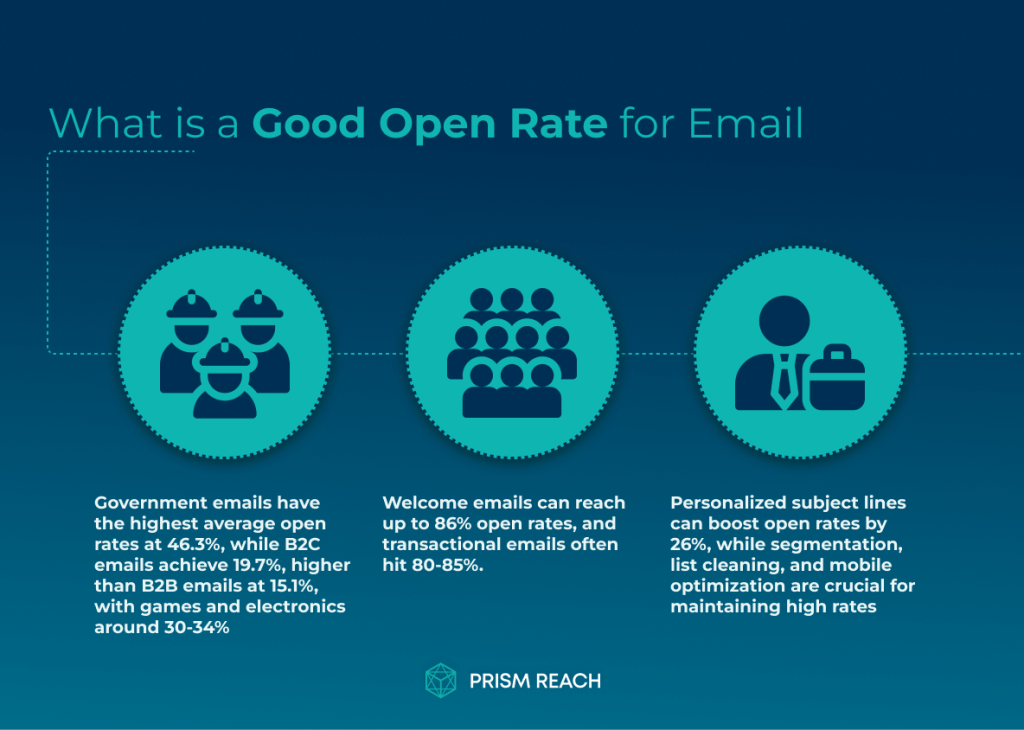
Integrating Hidden Gems: Advanced Strategies to Boost Open Rates
Beyond the fundamental factors, incorporating advanced strategies can give your email campaigns the edge they need to stand out. Here are five “hidden gems” strategies to consider:
1. Leverage Humor in Subject Lines
Humorous subject lines can break through the clutter of typical marketing emails. A witty or pun-filled subject line not only grabs attention but also sets a positive tone for the email content. For example, a subject line like “We’re Not Kitten Around – Check Out Our New Products!” can significantly increase open rates by making your email more relatable and enjoyable.
2. Experiment with Sender Names
Using a real person’s name instead of a generic company name can make your emails feel more personal and trustworthy. For instance, “Angie at Prism Reach” is likely to be more engaging than simply “Prism Reach.” This personal touch can improve open rates by up to 50%, as recipients feel they are receiving a message from an individual rather than a faceless entity.
3. Create Curiosity Gap Subject Lines
Subject lines that create a curiosity gap entice recipients to open the email to satisfy their curiosity. This psychological technique involves hinting at valuable information without revealing everything. For example, “Unlock the Secret to Doubling Your Open Rates” encourages recipients to open the email to learn more.
4. Implement Interactive Email Content
Interactive elements within emails, such as clickable buttons, image carousels, quizzes, surveys, and GIFs, can significantly enhance engagement. While this primarily affects click-through rates, it also influences open rates by making your emails more dynamic and appealing. Interactive content can result in a 300% increase in click rates, making your emails more memorable and encouraging future opens.
5. Use AI-Powered Email Optimization
Leveraging AI tools can transform your email marketing by analyzing customer data, providing personalized recommendations, optimizing subject lines, and predicting optimal send times. AI-powered optimization ensures that each email is tailored to the recipient’s preferences and behavior, maximizing the likelihood of opens and engagement.
Prism Reach: Elevating Your Email Marketing with AI-Powered Personalization
Prism Reach is an innovative AI-powered SaaS solution designed to enhance the effectiveness of email marketing campaigns through deep personalization. Here’s how Prism Reach can benefit your email marketing efforts:
Key Benefits of Prism Reach
- AI-Powered Personalization: Prism Reach uses sophisticated AI algorithms to create detailed user avatars and customize newsletter content based on subscriber behavior and preferences.
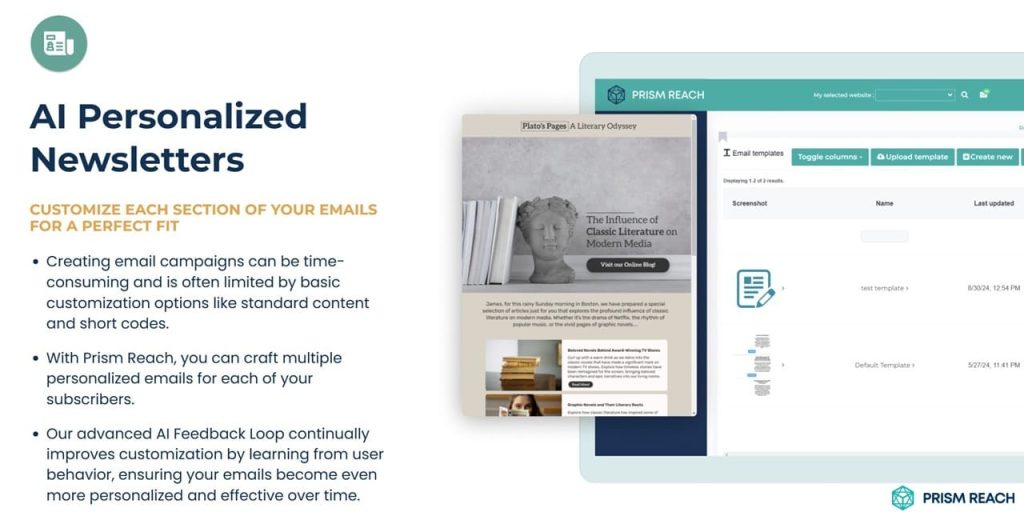
- Advanced List Segmentation: The platform allows for advanced segmentation based on demographics, interests, behavioral data, and customer personas, ensuring highly targeted and relevant emails.
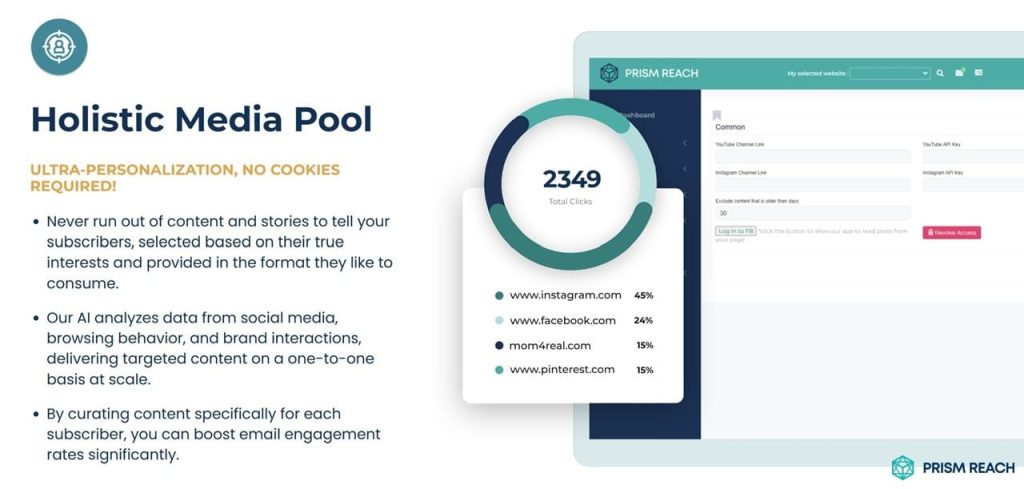
- Optimal Sending Times Prediction: Prism Reach’s predictive analytics determine the best times to send newsletters, maximizing subscriber engagement and open rates.
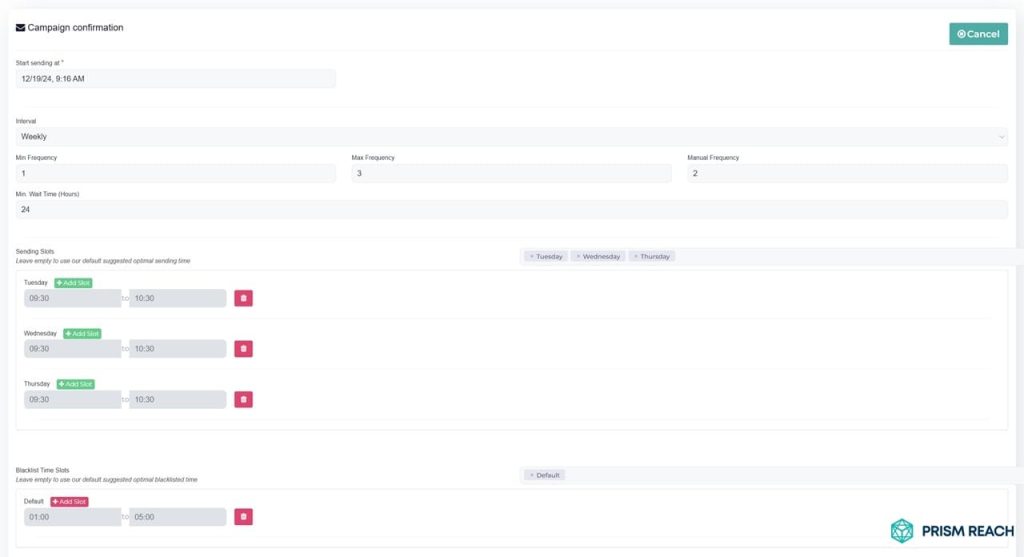
How Prism Reach Implements Hidden Gems Strategies
Prism Reach seamlessly integrates the hidden gems strategies into its functionality:
- Humorous Subject Lines: The AI-generated content suggestions can include creative and humorous subject lines tailored to your audience’s preferences.
- Personalized Sender Names: Prism Reach allows you to customize sender names, making your emails feel more personal and engaging.
- Curiosity Gap: The AI can craft subject lines that create a curiosity gap, enticing recipients to open your emails.
- Interactive Content: The dynamic content blocks feature enables the inclusion of interactive elements like quizzes and surveys.
- AI Optimization: The platform’s AI-driven optimization ensures every aspect of your email, from subject lines to send times, is tailored for maximum impact.
Practical Tips to Improve Your Email Open Rates
Implementing the following strategies can help you enhance your email open rates effectively:
1. Audit Your Current Performance
Begin by analyzing your current open rates across different email types and audience segments. Identify patterns and areas that need improvement:
- Review open rates for welcome, promotional, and transactional emails.
- Analyze performance across different audience segments.
- Identify trends in high-performing and underperforming campaigns.
2. Experiment with Subject Lines
A/B testing your subject lines can provide valuable insights into what resonates best with your audience:
- Test different lengths, tones, and personalization techniques.
- Incorporate humor, curiosity gaps, or shock factors where appropriate.
- Analyze the performance of each variation to determine the most effective approach.
3. Optimize Send Times
Finding the optimal time to send your emails can significantly impact open rates:
- Test sending emails at different times and days to identify peak engagement periods.
- Use AI-powered tools like Prism Reach to predict the best send times for individual subscribers.
- Adjust your email schedule based on the insights gathered from testing.
4. Segment Your List
Effective segmentation ensures that your emails are relevant to each recipient:
- Divide your subscribers based on demographics, behavior, and preferences.
- Create targeted campaigns for each segment to increase relevance.
- Use Prism Reach’s advanced segmentation features to automate and enhance this process.
5. Clean Your List
Maintaining a clean email list is vital for high open rates:
- Regularly remove inactive subscribers and invalid email addresses.
- Use Prism Reach’s AI-enhanced sign-up forms to ensure high-quality list growth.
- Monitor engagement metrics to identify and address list hygiene issues proactively.
6. Focus on Providing Value
Ensure that every email you send offers clear value to the recipient:
- Deliver relevant and actionable content that meets your audience’s needs.
- Build trust by consistently providing high-quality information.
- Use Prism Reach’s dynamic content selection to tailor each newsletter to individual preferences.
Enhancing Your Email Marketing with Prism Reach
Prism Reach is not just another email marketing tool; it’s a comprehensive solution designed to elevate your email campaigns through advanced AI-driven features. Here’s how Prism Reach can help you achieve a good, and even excellent, open rate for your emails:
- AI-Powered Personalization: Customize every aspect of your newsletters based on subscriber behavior and preferences.
- Advanced List Segmentation: Target specific audience segments with tailored content to increase relevance and engagement.
- Optimal Sending Times: Utilize predictive analytics to send emails when your subscribers are most likely to engage.
By leveraging these features, Prism Reach ensures that your email marketing strategies are not only effective but also continuously optimized for the best possible performance.
Upgrade Your Email Marketing with AI Personalization!
FAQ
Conclusion: Elevating Your Email Marketing Game
Determining what constitutes a “good” open rate for your email campaigns involves a nuanced understanding of various factors, including industry benchmarks, audience behavior, and the type of emails you send. By implementing strategic approaches such as leveraging humor in subject lines, experimenting with sender names, creating curiosity gaps, incorporating interactive content, and utilizing AI-powered optimization, you can significantly enhance your email open rates.
Tools like Prism Reach play a pivotal role in this process by offering advanced features that automate and optimize these strategies. From AI-driven personalization and advanced list segmentation to predicting optimal send times, Prism Reach equips marketers with the tools necessary to create highly effective and engaging email campaigns.
Remember, improving your open rates is an ongoing journey that requires continuous testing, analysis, and refinement. By focusing on providing value, maintaining list hygiene, and leveraging advanced tools like Prism Reach, you’ll be well on your way to achieving not just good open rates, but truly impactful email marketing campaigns that drive real results for your business.
Final Thoughts on Achieving “Good” Open Rates
While striving for “good” open rates is important, it’s essential to view open rates as part of a broader email marketing strategy. Combining open rates with other metrics like click-through rates, conversion rates, and overall ROI provides a more comprehensive view of your campaign’s success.
As email marketing evolves and subscriber behaviors shift, staying informed about industry trends and continuously optimizing your strategies will be crucial. Embrace tools like Prism Reach that leverage AI to stay ahead of the curve, ensuring your emails not only get opened but also engage and convert your audience effectively.
By focusing on building and nurturing relationships with your subscribers through relevant, valuable content and personalized experiences, you’ll achieve not just good open rates, but truly effective email marketing campaigns that drive meaningful engagement and business growth.